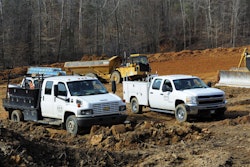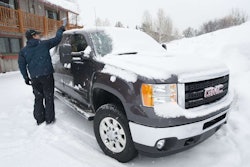Mobil Delvac Big Red
Big Red Part VI: Duramax Power Tune
 It’s all about fine-tuning the “0”s and “1”s; Hypertech’s Max Energy programmer adds needed muscle to our dually’s 6.6L Duramax
It’s all about fine-tuning the “0”s and “1”s; Hypertech’s Max Energy programmer adds needed muscle to our dually’s 6.6L Duramax
By Bruce W. Smith
Hypertech tuning manager John Lambert reaches below the steering column, plugs a thick black cord into the open socket of the exposed diagnostic port, then makes a half-dozen movements with his right thumb that rests lightly on the only button on the Hypertech Energy Max programmer cupped in his hands.
Ten minutes later I am looking at a printout of the Superflow dyno results.
It shows our Mobil Delvac-sponsored 2008 GMC Sierra’s performance: a gain of 88hp and 156 pound-feet in torque over the stock 6.6L Duramax numbers we’d pulled less than a half hour earlier.
 Stage 3 on Hypertech’s Max Energy programmer yielded an additional 88hp over the stock Duramax and, more importantly, a 25-percent bump in load-moving torque.
Stage 3 on Hypertech’s Max Energy programmer yielded an additional 88hp over the stock Duramax and, more importantly, a 25-percent bump in load-moving torque.
That’s the beauty of diesel tunes. When your pickup’s diesel is running the right one, the performance gains are impressive – and 50-state legal.
A NEED FOR SPEED
We’ve come a long way with the Mobil Delvac Big Red since the project began almost one year ago.
The truck stands taller, is well outfitted and is fully capable of motoring across off-pavement and off-road terrain that would leave lesser four-wheel-drive pickups spinning their wheels.
But Big Red is also heavy. Our long-bed crew-cab dually’s stock curb weight is just shy of 7,400 pounds.
To that we added some 1,600 pounds in the removable service body and equipment; another 500 pounds in heavy-duty winches and bumpers; 300 pounds in tires/wheels; and 200 to 300 pounds in suspension and other upgrades.
Those upgrades and additions push Big Red close to its 11,400-pound GVWR, and it feels like it on the road.
 The Duramax uses every one of its 365 ponies and 660 pound-feet of torque to motor Big Red down the road. The truck cruises fine, but acceleration is getting on the marginal side of what one would call performance.
The Duramax uses every one of its 365 ponies and 660 pound-feet of torque to motor Big Red down the road. The truck cruises fine, but acceleration is getting on the marginal side of what one would call performance.
THE HYPERTECH EDGE
In short, what the Mobil Dlevac Big Red GMC needs now is a boost in power to offset its new-found bulk.
So we turned to the engine-tuning experts at Hypertech (hypertech.com; 901-382-8888) for a solution.
“Fuel is your primary focus of building power in a diesel,” says Lambert, who has been Hypertech’s tuning manager for more than a decade.
 Uploading the Hypertech power tunes takes about 10 minutes the first go-‘round and less than 5 minutes thereafter. Built-in instructions make changes easy.
Uploading the Hypertech power tunes takes about 10 minutes the first go-‘round and less than 5 minutes thereafter. Built-in instructions make changes easy.
“So we make incremental adjustments to the injector pulse widths and watch how those changes affect the engine’s power curve on the dyno. A longer pulse width, more fuel.”
Lambert says the Hypertech tuning team also pays very close attention to turbo inlet/outlet and exhaust temperatures.
Hypertech’s programmers are constantly watching brake specific fuel consumption (BSFC) – the fuel-to-power ratio.
When they see either a “point of diminishing return” in power related to the amount of fuel being sent into the cylinders – or temperatures rising above a certain threshold that would endanger engine longevity, they back down those adjustments.
“Once we have found the sweet spot on fuel, then we concentrate on adjusting timing,” explains Lambert.
“We make finite quantity changes in fuel timing and then follow the dyno results to see where the efficiency and performance begins to fall off. Once that’s achieved we go back to the first parameter, fuel quantity, and make more adjustments.”
 Big Red’s 22-inch American Force wheels and 35×12.50 Toyo M/Ts were too wide to fit on dyno drums, so outside wheels had to be removed for our tests.
Big Red’s 22-inch American Force wheels and 35×12.50 Toyo M/Ts were too wide to fit on dyno drums, so outside wheels had to be removed for our tests.
That tuning cycle continues back and forth until the programmers feel like they have reached the optimum combination of those two factors while keeping engine durability maximized.
“From there we may go on to boost pressure, fuel-injection pressure or any other parameters we can adjust to fine-tune the program to optimize the power output for the quantity of fuel used,” says Lambert.
Setting up a tune is very time-consuming and requires many, many hours of a truck sitting on one of the company’s two chassis dynos.
For example, Lambert says they put more than 2,000-plus dyno pulls on a 2007 Duramax to get the tune that they use for the LMM found in our 2008 GMC Sierra.
“We aren’t looking to make the absolute maximum power with our tunes,” explains Hypertech’s hed programmer.
“What we are looking for is maximizing efficiency and performance when the truck is being used within its factory limitations.
“We want to make sure in worst-case use, where your foot is on the floor with a big trailer in-tow up a steep grade for 20 minutes, your truck is still going to be OK.”
ON THE ROLLERS
Lambert and his tech team strapped Big Red on the main dyno and ran a number of runs to see what it was making in stock form.
 Max Energy tuner allows user to program in the truck’s tire height so speedometer is calibrated. Big Red’s Toyo M/Ts are 35-inchers.
Max Energy tuner allows user to program in the truck’s tire height so speedometer is calibrated. Big Red’s Toyo M/Ts are 35-inchers.
Then he pulled out the Max Energy programmer and loaded in Stage 1, the mildest of their Duramax tunes. This added 142 pound-feet and 80hp. Stage 2 only added 3 more ponies.
Stage 3, the most aggressive, and what Lambert says he recommends for those with heavy pickups, hauling heavy loads or pulling bigger trailers, added another 10 ft/lbs and 5hp.
That’s the program we left stored in Big Red’s ECU.
ON THE ROAD
One of the most gratifying driving experiences is when you make a performance upgrade and when you get on the road you can actually feel the difference.
That’s exactly what we got with the Hypertech Max Energy software upgrade.
Where Big Red felt sluggish and required a fairly heavy right foot to get its 10,000-pound bulk up to Interstate speeds, I actually had to back off the throttle before the on-ramp lane ran out to keep speed under 70mph.
Maintaining 70mph cruise speed required nothing more than a breath of foot on the throttle.
And moving into the fast lane to sweep around some slower-moving semis required the briefest of throttle-down as those 80-plus horses kicked up their hooves. This truck runs.
Around town one has to keep a constant eye on the speedometer (it’s calibrated now, thanks to the programmer) or else you’re rolling along at 45mph instead of 35.
Fuel economy has also seen a nice boost.
On the 245-mile trip north from Tuscaloosa to Bartlett, Tennessee, home of Hypertech, Big Red sucked down fuel at the rate of 9.8mpg running 70mph on the Interstates.
The return trip yielded 11.9mpg, a 2.1mpg improvement.
Running empty, with the slide-in service body removed, should be equally impressive in both driving performance and fuel economy.
This is one of those performance upgrades we should have done right out of the chute. But hindsight is always 20/20, right?
“It’s just as easy to put the engine back to stock,” says Lambert. “Just plug in the cable and the Max Energy tuner will lead you through the simple steps to put the OE program back into play.”
Yes, the steps might be simple. But we are quite content with how strong Big Red is running right now. Maybe the sweepstakes winner will make that change when they get the keys in April.
“BIG RED” Presented by Mobil Delvac
SPONSORS
- American Force Wheels: americanforcewheels.com; 800-620-6259
- Amp Research: amp-research.com; 800-309-6823
- B&W Trailer Hitches: turnoverball.com; 800-248-6564
- Barkley GMC: barkleygmc.com; 205-556-6600
- BD Diesel Performance: dieselperformance.com; 800-887-5030
- BOLT: boltlock.com; 877-251-8798
- Buyer’s Products Company: buyersproducts.com; 440-974-8888
- Fab Fours Bumpers: fabfours.com; 866-385-1905
- Fleetwest: fleetwest.net; 866-497-7200
- Hellwig Products: hellwigproducts.com; 800-435-5944
- Husky Liners: huskyliners.com; 800-344-8759
- Hypertech: hypertech.com; 901-382-8888
- Marathon Seat Covers: marathonseatcovers.com; 800-735-2769
- Mile Marker: milemarker.com; 800-886-8647
- Toyo Tires: toyotires.com; 800-442-8696
- Transfer Flow: transferflow.com; 800-442-0056
- Truck Supply & Outfitters: trucksupplyandoutfitters.com; 205-553-4203
- USFleet Tracking: usft.com; 405-749-1105
- Vanair: vanair.com; 800-526-8817








